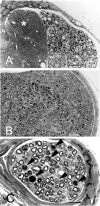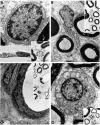Degeneration of myelinated efferent fibers prompts mitosis in Remak Schwann cells of uninjured C-fiber afferents
- PMID: 15689554
- PMCID: PMC6725954
- DOI: 10.1523/JNEUROSCI.1372-04.2005
Degeneration of myelinated efferent fibers prompts mitosis in Remak Schwann cells of uninjured C-fiber afferents
Abstract
The factors inducing normally innervated Schwann cells in peripheral nerve to divide are poorly understood. Transection of the fourth and fifth lumbar ventral roots (L4/5 ventral rhizotomy) of the rat is highly selective, sparing unmyelinated axons and myelinated sensory axons; Wallerian degeneration is restricted to myelinated efferent fibers. We found that L4/5 ventral rhizotomy prompted many normally innervated nonmyelinating (Remak) Schwann cells to enter cell cycle; myelinating Schwann cells of intact (sensory) axons did not. Three days after L4/5 ventral rhizotomy, [3H]thymidine incorporation into Remak Schwann cells increased 30-fold. Schwann cells of degenerating efferents and endoneurial cells also incorporated label. Increased [3H]thymidine incorporation persisted at least 10 d after ventral rhizotomy. Despite Remak Schwann cell proliferation, the morphology of unmyelinated nerve (Remak) bundles was static. Seven days after L5 ventral rhizotomy, Remak Schwann cells in the L5-predominant lateral plantar nerve increased slightly; endoneurial cells doubled. Terminal deoxynucleotidyl transferase-mediated biotinylated UTP nick end labeling-positive nuclei increased dramatically in peripheral nerve after L5 ventral rhizotomy; many of these were macrophage nuclei. In summary, we find that the degeneration of myelinated motor axons produced signals that were mitogenic for nonmyelinating Schwann cells with intact axons but not for myelinating Schwann cells with intact axons.
Figures






Similar articles
-
Degeneration of myelinated efferent fibers induces spontaneous activity in uninjured C-fiber afferents.J Neurosci. 2002 Sep 1;22(17):7746-53. doi: 10.1523/JNEUROSCI.22-17-07746.2002. J Neurosci. 2002. PMID: 12196598 Free PMC article.
-
Comparison of cytokine expression profile during Wallerian degeneration of myelinated and unmyelinated peripheral axons.Neurosci Lett. 2008 Jan 17;430(3):230-5. doi: 10.1016/j.neulet.2007.11.003. Epub 2007 Nov 6. Neurosci Lett. 2008. PMID: 18068300
-
Contribution of degeneration of motor and sensory fibers to pain behavior and the changes in neurotrophic factors in rat dorsal root ganglion.Exp Neurol. 2004 Jul;188(1):149-60. doi: 10.1016/j.expneurol.2004.03.012. Exp Neurol. 2004. PMID: 15191811
-
Biology and pathology of nonmyelinating Schwann cells.Glia. 2008 Nov 1;56(14):1518-1531. doi: 10.1002/glia.20778. Glia. 2008. PMID: 18803315 Review.
-
Schwann cells: activated peripheral glia and their role in neuropathic pain.Brain Behav Immun. 2007 Jul;21(5):522-7. doi: 10.1016/j.bbi.2006.12.008. Epub 2007 Feb 26. Brain Behav Immun. 2007. PMID: 17321718 Free PMC article. Review.
Cited by
-
Axonal regulation of Schwann cell ensheathment and myelination.J Peripher Nerv Syst. 2012 Dec;17 Suppl 3(0 3):14-9. doi: 10.1111/j.1529-8027.2012.00425.x. J Peripher Nerv Syst. 2012. PMID: 23279426 Free PMC article. Review.
-
After Nerve Injury, Lineage Tracing Shows That Myelin and Remak Schwann Cells Elongate Extensively and Branch to Form Repair Schwann Cells, Which Shorten Radically on Remyelination.J Neurosci. 2017 Sep 13;37(37):9086-9099. doi: 10.1523/JNEUROSCI.1453-17.2017. Epub 2017 Aug 3. J Neurosci. 2017. PMID: 28904214 Free PMC article.
-
Advances in peripheral nerve regeneration.Nat Rev Neurol. 2013 Dec;9(12):668-76. doi: 10.1038/nrneurol.2013.227. Epub 2013 Nov 12. Nat Rev Neurol. 2013. PMID: 24217518 Review.
-
Schwann cells, but not Oligodendrocytes, Depend Strictly on Dynamin 2 Function.Elife. 2019 Jan 16;8:e42404. doi: 10.7554/eLife.42404. Elife. 2019. PMID: 30648534 Free PMC article.
-
Beyond Wrapping: Canonical and Noncanonical Functions of Schwann Cells.Annu Rev Neurosci. 2022 Jul 8;45:561-580. doi: 10.1146/annurev-neuro-110920-030610. Epub 2022 Apr 19. Annu Rev Neurosci. 2022. PMID: 35440141 Free PMC article. Review.
References
-
- Avellino AM, Hart D, Dailey AT, MacKinnon M, Ellegala D, Kliot M (1995) Differential macrophage responses in the peripheral and central nervous system during wallerian degeneration of axons. Exp Neurol 136: 183-198. - PubMed
-
- Baichwal RR, DeVries GH (1989) A mitogen for Schwann cells is derived from myelin basic protein. Biochem Biophys Res Commun 164: 883-888. - PubMed
Publication types
MeSH terms
Grants and funding
LinkOut - more resources
Full Text Sources
